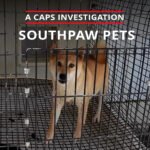Breeder: McDuffee, Gary and Wanda
Business name: Happy Tails Kennel
Address: 1805 Riverview Dr.
City, State Zip: Little Falls, MN 56345
Year: 2005
USDA License: 41-B-0190
Date of CAPS Investigation: 2005-06-13 and 2005-06-13
Approximately 380 dogs and an undetermined number of puppies in the kennel
Breeds: Poodles, Bichon Frisees, West Highland Terriers, Yorkshire Terriers, Shih Tzus, Pekingese, Lhasa Apsos, Italian Greyhounds, Scottish Terriers, Beagles, Pugs, Dachshunds, Cairn Terriers, Miniature Schnauzers, Airedale Terriers, Chihuahuas, Maltese, Cavalier King Charles Spaniels, Cocker Spaniels
Happy Tails Kennel was a U-shaped building with a peaked metal roof, metal doors accessing it from all sides, and indoor/outdoor cages on three of its four longest walls (the wall facing the direction of Riverview Dr. did not have cages). Each of the outside walls had about 50 cages, while the inside walls had about 40.
Each of the outside cages was raised about three feet above the ground on wooden stilts. They measured about two feet wide, two feet long, and two feet high and had untreated, thin-gauge wire walls and ceilings (3.6(a)(2)(xii)-Primary enclosures) and treated-wire floorings. The cages were framed underneath by rusting metal beams (3.1(c)(1)(i)-Surfaces). Stainless-steel water buckets were attached to the outside wall of each outdoor cage. Each enclosure housed two dogs.
A paved walkway ran underneath and next to the cages along the outside of the building’s longest walls. The ground directly under the cages was dirt, and several weeks of fecal accumulation was piled underneath the cages amidst stagnant, standing water filled with algae. The outdoor cages on the inside of the U (the outdoor cages that faced each other) also were positioned over dirt ground and had several weeks’ accumulation of feces piled under them. Rain had created small pools of feces-filled water underneath the cages and in the walkway in between the rows. In addition, several days’ accumulation of feces was observed inside about 10 percent of the cages, most of it dried and piled up in the center of the cage (3.11(a)-Cleaning of primary enclosures) 3.1(f)-Drainage and waste disposal). Flies were swarming around the outside of the facility (3.11(d)-Pest control).
The wooden building siding that served as the back wall of these cages was covered with fecal stains, fur, and algae build-up (3.1(c)(1)-Surfaces).
A West Highland Terrier had feces-stained mats covering its chest and belly (2.40-Vet care) in a cage on the wall opposite the direction of Riverview Rd. There were two cages housing Airedale Terriers that lacked six inches of space above the tops of the dogs’ heads (3.6(c)(1)(iii)-Primary enclosures).
Indoor cages
The indoor cages were of the same design and dimensions as the outdoor cages and were accessed from the outside cages by metal doggie doors. The indoor cages had metal self-feeders attached to the cage walls. Flooring was concrete.
A room closest to the parking area of the building contained indoor cages about 2.5 feet wide, 1.5 feet long, and 1.5 feet high. These cages were stacked on top of each other, three high in six different stacks. Each housed a single dog. One cage housed an Airedale Terrier, another housed a Sheltie, and another a Cocker Spaniel; each dog was about 1.5 feet long from tips of their noses to the bases of their tails (3.6(c)(1)(i)-Primary enclosures). These cages lacked six inches of space above the tops of the dogs’ heads (3.6(c)(1)(iii)-Primary enclosures).
Metal trays underneath the treated wire floorings of the stacked cages served to catch feces and debris. The walls and tops of the cages were made of untreated, thin-gauge wire (3.6(a)(2)(xi)-Primary enclosures). All of these cages had metal self feeder and plastic water bottles attached to their walls.




